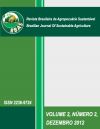COMPARAÇÃO ENTRE MÉTODOS DE RISCO DE QUEIMADAS PELO ÍNDICE DE HAINES, ANGSTRÖM, MONTE ALEGRE E O HIDROTERMOMÉTRICO NA REGIÃO DE VIÇOSA-MG NO PERÍODO DE 01 A 30 DE SETEMBRO DE 2003
DOI:
https://doi.org/10.21206/rbas.v2i2.179Resumo
Foram elaborados vários métodos para indicar o desenvolvimento de queimadas, sendo que todos possuem suas particularidades e procedimentos próprios; porém, todos dependem das condições atmosféricas envolventes e dados meteorológicos. Os princípios básicos são: altas temperaturas e umidade e índices pluviométricos baixos, onde estes parâmetros associados aumentam as possibilidades de ocorrer queimadas incontroláveis e acidentais. Existem métodos não acumulativos e os métodos cumulativos, em que os métodos não cumulativos baseiam-se somente nas condições do tempo vigente no dia, como exemplo o Fator de Risco de Angström. Os métodos cumulativos consideram as condições climáticas de uma sucessão de dias, como por exemplo: Fórmula de Monte Alegre, Índice Higrotermométrico e o Índice de Haines. Assim, serão comparados todos estes índices para verificar qual destes métodos teria maior índice de acertos em relação ao desenvolvimento das queimadas reais. As queimadas e incêndios florestais causam, adicionalmente, custos e degradação ambiental e são fatores negativos para a sociedade como um todo. Um dos principais efeitos é a liberação de quantidades significativas de carbono para a atmosfera pela queima de biomassa vegetal, que contribui com o aquecimento global, mais conhecido como efeito estufa. A cada ano, em todo o mundo, áreas de florestas equivalentes ao território de Portugal são destruídas. Este estudo visa indicar qual melhor método para o gerenciamento e monitoramento dos riscos de queimadas para o Brasil, sendo utilizado o dia 25 do mês de setembro de 2003, como estudo de caso, pois foi considerado o dia mais crítico em relação a queimadas e incêndios durante este mês e também será estudado os métodos durante todo o mês, objetivando a comparação destes para o Município de Viçosa- MG. Os valores indicados pelos métodos demonstrarão as variações particulares de cada um. A oscilação entre os métodos proverá ajuda para o gerenciamento de áreas críticas e tomadas de decisões estratégicas para o controle de queimadas, assim como verificar o comportamento de cada método objetivando resultados descritivos comportamentais e individuais das queimadas, para que posteriormente possa ocorrer operacionalmente o controle e gerenciamento deste fenômeno e indicar o melhor método.Downloads
Downloads
Publicado
2012-12-01
Como Citar
Carlos Fernando Lemos, Flávio Justino, & Hygor Aristides Rossoni. (2012). COMPARAÇÃO ENTRE MÉTODOS DE RISCO DE QUEIMADAS PELO ÍNDICE DE HAINES, ANGSTRÖM, MONTE ALEGRE E O HIDROTERMOMÉTRICO NA REGIÃO DE VIÇOSA-MG NO PERÍODO DE 01 A 30 DE SETEMBRO DE 2003. Revista Brasileira De Agropecuária Sustentável, 2(2). https://doi.org/10.21206/rbas.v2i2.179
Edição
Seção
Artigos
Licença
1. Proposta de Política para Periódicos de Acesso Livre
Autores que publicam nesta revista concordam com os seguintes termos:
Autores mantém os direitos autorais e concedem à revista o direito de primeira publicação, com o trabalho simultaneamente licenciado sob a Licença Creative Commons Attribution que permite o compartilhamento do trabalho com reconhecimento da autoria e publicação inicial nesta revista.












